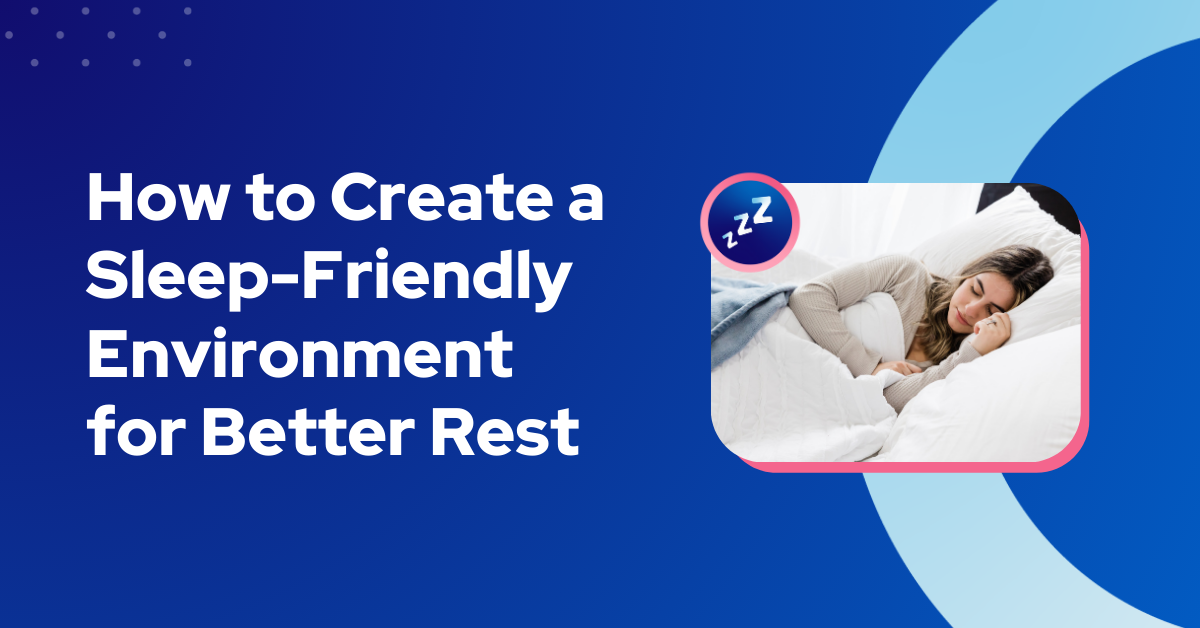How to Create a Sleep-Friendly Environment for Better Rest
Sleep is a cornerstone of good health, affecting everything from mood and memory to immune function and heart health. Yet, for many, achieving high-quality sleep remains elusive. A key factor often overlooked is the environment in which we sleep. By creating a sleep-friendly environment, you can set yourself up for more restful nights and energized mornings.
Why a Sleep-Friendly Environment Matters
Your surroundings play a critical role in signaling your body that it’s time to rest. A poorly designed sleep space can disrupt circadian rhythms, increase stress levels, and make it harder to fall and stay asleep.
The Centers for Disease Control and Prevention (CDC) reports that about 1 in 3 adults in the U.S. don’t get enough sleep (less than 7 hours per night)【1】.

Key Elements of a Sleep-Friendly Environment
1. Optimize Your Bedroom Temperature
Why It Matters:
Your body temperature naturally drops during sleep. A room that’s too hot or cold can disrupt this process, leading to restless nights.
Ideal Temperature: Experts recommend keeping your bedroom between 60-67°F (15-19°C) for optimal sleep【2】.
What to Do:
-
Use a programmable thermostat to maintain a consistent temperature.
-
Opt for breathable bedding materials like cotton or bamboo.
-
Use a fan for air circulation during warmer months.
2. Block Out Light
Why It Matters:
Light exposure suppresses the production of melatonin, the hormone responsible for regulating sleep. Even small amounts of light can disrupt your sleep cycle.
What to Do:
-
Install blackout curtains to block outdoor light.
-
Use dim, warm-toned lighting in the evenings to mimic natural sunset hues.
-
Eliminate blue light from screens at least 1-2 hours before bed.
Tip: Consider wearing a sleep mask if complete darkness isn’t possible.
3. Minimize Noise
Why It Matters:
Noise disturbances—even subtle ones—can prevent you from reaching deep, restorative sleep stages like REM.
What to Do:
-
Use white noise machines or apps to mask disruptive sounds.
-
Invest in noise-reducing materials like thick rugs, curtains, or acoustic panels.
-
Wear earplugs if you live in a particularly noisy area.
Statistic: Noise at night has been shown to increase the risk of sleep fragmentation, with 20-30% of urban residents reporting noise as a significant sleep disruptor【3】.
4. Invest in a Supportive Mattress and Pillow
Why It Matters:
Your mattress and pillow affect spinal alignment, comfort, and pressure point relief—all of which influence sleep quality.
What to Do:
-
Choose a mattress with the right firmness for your sleeping position (soft for side sleepers, firmer for back or stomach sleepers).
-
Use pillows that support your neck and promote alignment with your spine.
Tip: Replace your mattress every 7-10 years and pillows every 1-2 years.

5. Reduce Clutter
Why It Matters:
A cluttered bedroom can create a sense of stress and overstimulation, making it harder to unwind and relax before bed.
What to Do:
-
Keep surfaces clear and store items out of sight.
-
Limit bedroom décor to calming, neutral tones.
-
Use storage solutions like under-bed bins or minimalist shelving.
Statistic: A study found that people who describe their bedrooms as “cluttered” are 40% more likely to experience poor sleep quality【4】.
6. Incorporate Relaxing Scents
Why It Matters:
Certain scents, like lavender and chamomile, have been shown to reduce stress and improve sleep quality.
What to Do:
-
Use essential oil diffusers or linen sprays with calming scents.
-
Avoid strong or synthetic fragrances that might trigger allergies.
Studies indicate that lavender aromatherapy can improve sleep quality by 20% in people with mild sleep disorders【5】.
7. Create a Tech-Free Zone
Why It Matters:
Electronics emit blue light and can overstimulate the brain, making it harder to wind down.
What to Do:
-
Charge devices outside the bedroom or set them to "Do Not Disturb" mode.
-
Replace screen time before bed with calming activities like reading or meditation.
Tip: Use an analog alarm clock instead of your phone to wake up.
How Spot Pal Can Help Improve Sleep
Spot Pal, a patented tongue training device, is designed to optimize breathing and jaw alignment, which are critical for restful sleep. Here’s how it works:
-
Promotes nasal breathing: Improves oxygen flow and reduces snoring.
-
Supports proper tongue posture: Relieves strain on the jaw and airways.
-
Reduces sleep apnea symptoms: Encourages uninterrupted, restorative sleep.

Creating a sleep-friendly environment is essential for improving rest and overall well-being. By addressing factors like temperature, noise, lighting, and clutter, you can set the stage for better sleep. Tools like Spot Pal can further enhance your efforts, helping you breathe better and wake up refreshed.
Sources
-
Centers for Disease Control and Prevention
-
National Sleep Foundation
-
Journal of Environmental Health
-
Sleep and Health Journal
-
International Journal of Aromatherapy

Share:
Daily Habits That Can Worsen TMJ Pain
Tongue Thrust: Understanding and Treating This Common Oral Condition